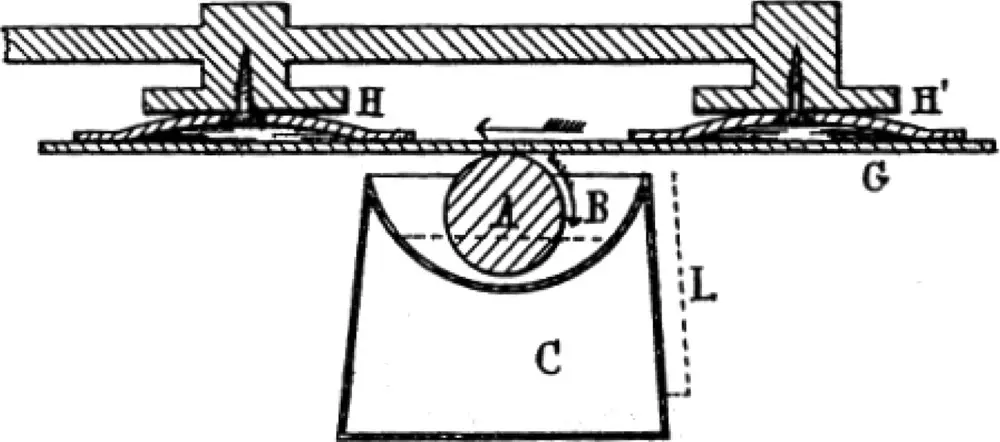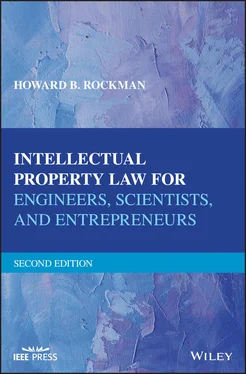9.8 EXECUTION OF THE DECLARATION, POWER OF ATTORNEY, AND ASSIGNMENT UPON COMPLETION OF THE PATENT APPLICATION
Upon completion of the review of your patent application, including the claims, which are covered in detail in Chapter 10, documents commonly known as the “formal papers” are completed and furnished to the USPTO along with the application. These papers constitute a Declaration (or Oath) that the inventor or inventor(s) sign, as described in Section 9.7.
Where the patent application has been prepared by a patent attorney or agent who will be responsible for the continued prosecution of the application through examination by the USPTO, a Power of Attorney form is executed by the inventor(s), providing the attorney or agent with the power to prosecute the application further on behalf of the inventor(s) or the applicant, such as the inventor’s employer.
If the invention is to be owned by a corporation or other entity or group of entities other than the inventor or inventors, an Assignment document is also signed by the inventors, granting all rights, title and interest, or portions thereof, of the invention and patent application to the assignee. The Assignment document, the formal papers, and the patent application are then submitted to the USPTO with the appropriate government filing fee. The Assignment document is recorded by the USPTO, and returned to your attorney.
An Application Data Sheet (ADS) is also filed with the application, identifying the title of the invention, the names and mailing address and country of residence of each inventor, correspondence information of the attorney or agent representing the inventor(s), prior patent applications related to the application being filed or upon which priority is based, foreign priority information, if applicable, and other information regarding the application. In addition, under the AIA and 37 CFR §1.605, it is now possible to designate as the applicant in the ADS the employer or other entity to whom the inventor(s) have assigned the invention, or to whom the inventor(s) are obligated to assign the invention pursuant to a contract or an employment agreement (the employment agreement is considered as a contract) or to a person who otherwise shows sufficient proprietary interest in the invention. The ADS is signed by the patent attorney or agent when completed.
In addition, to comply with the provision of the USPTO rules that the inventor and the inventor’s attorney must submit all material prior art that they are aware of to the Patent Examiner, it is normal practice for the patent attorney to prepare and file with the patent application, or shortly thereafter, an IDS, which lists all prior art known by the applicant and the attorney, for consideration by the Patent Examiner. The IDS consists of:
1 A list of all relevant U.S. patents and U.S. patent application publications known by the applicant and attorney for consideration by the Patent Examiner.
2 A legible copy of each foreign patent or patent application publication or portions thereof, and a legible copy of other literature information identified in the IDS.
3 An explanation of the relevance of any patent publication or other information not in the English language, and a copy of any translation of same if in the inventor(s) or attorney’s possession.
All the above formal documents are submitted to the USPTO along with the completed patent application to initiate the examination process. The IDS can also be submitted to the Patent Examiner at any time prior to the initial examination, without monetary penalty. Also, the inventor and the inventor’s attorney have a continuing obligation to submit material prior art they become aware of to the Patent Examiner up to the date the patent issues. This is an important point to remember, and cannot be stressed enough.
Your patent attorney will advise you that certain applicants may qualify for reduced government filing fees as “small entities” or “micro entities,” and what the criteria are for qualifying for the reduced fees. If the applicant(s) so qualify, the status of the applicant is provided with the initial information furnished to the USPTO when the patent application is filed.
INVENTORS AND INVENTIONS
George Eastman
PRACTICAL PHOTOGRAPHY

George Eastman is responsible for making photography practical, widely available, and more convenient, since his invention made it possible to take a camera anywhere. He was born on July 12, 1854, in the same house in which his father was born in the village of Waterville, New York. When George was five, his family moved to Rochester, New York, where his oldest sibling established the Eastman Commercial College. When the college failed and George’s father died, the family became financially unstable.
George quit school at the age of fourteen to start working to support the family. He had several jobs working at insurance firms and the Rochester Savings Bank, and his pay ranged from three to fifteen dollars per week. When Eastman was twenty‐four, he made plans to take a trip to Santo Domingo. Following a suggestion from a coworker at the bank, Eastman bought a photographic outfit equipped with all the supplies needed for wet‐plate photography. His camera was as big as a sewing machine and required a heavy tripod as a support. He also purchased plate holders, chemicals, tanks, and a tent, all of which were necessary to be able to apply photosensitive emulsion on glass plates, expose the emulsion, and then develop the images before the emulsion dried. This amounted to approximately 50 pounds of equipment. Eastman said that the equipment “was a packhorse load.”
After all this, Eastman did not make the trip, but he was enticed to find an easier way to take pictures. In 1877, after reading in British journals about photographers creating their own dry gelatin emulsions, which meant that even after the plates became dry they were still sensitive to light, Eastman decided he would do the same. Beginning with a formula he obtained from one of the British journals, he worked on creating his own gelatin emulsions almost nonstop. After three years of working in the bank during the day, and experimenting in his mother’s kitchen at night, he came up with a formula for dry plates that worked, and by 1880 he had obtained patents covering both his formula and a machine that prepared large numbers of plates.
Eastman leased a floor of a building in Rochester in April 1880 to begin manufacturing his dry plates for sale. His company prospered and grew, but faced a downturn at least once when plates went bad in the hands of dealers and Eastman recalled them and replaced the faulty plates with good ones. This recall was costly, but it greatly enhanced Eastman’s reputation.
In 1884, Eastman started working on ways to make a photographic film lighter than the dry plates that were backed by glass. His first attempt was to put the photographic emulsion on a flexible backing such as paper, and then load it into a roll holder. Despite some flaws, this development was a huge success. But, Eastman found that imperfections on or in the texture of the paper were transferred to the developed image. He then decided to eliminate this problem by applying a soluble layer of gelatin over the insoluble light‐sensitive gelatin layer. After development, the soluble gelatin layer bearing the image was lifted off, and the insoluble layer was transferred to a sheet of clear gelatin and varnished with collodion, a cellulose mixture that hardened into a rigid, transparent film. His development of transparent roll film and a roll holder resulted in the introduction of the Kodak® Camera in 1888, the first camera built to hold roll film. Film rolls capable of holding 100 pictures were loaded in the camera. After exposure, the entire camera and film were sent back to Eastman’s company, where the film was developed, the camera was reloaded and returned to the customer, all for $25.00.
Читать дальше













